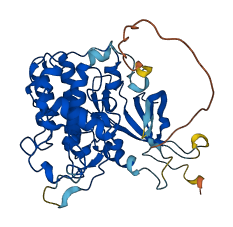Q5ZKN1
Gene name |
CDK9 (RCJMB04_9p8) |
Protein name |
Cyclin-dependent kinase 9 |
Names |
Cell division protein kinase 9 |
Species |
Gallus gallus (Chicken) |
KEGG Pathway |
gga:417226 |
EC number |
2.7.11.22: Protein-serine/threonine kinases |
Protein Class |
|

Descriptions
The autoinhibited protein was predicted that may have potential autoinhibitory elements via cis-regPred.
Autoinhibitory domains (AIDs)
Target domain |
|
Relief mechanism |
|
Assay |
cis-regPred |
Accessory elements
166-193 (Activation loop from InterPro)
Target domain |
19-315 (Protein kinase domain) |
Relief mechanism |
|
Assay |
|
Autoinhibited structure

Activated structure

1 structures for Q5ZKN1
| Entry ID | Method | Resolution | Chain | Position | Source |
|---|---|---|---|---|---|
| AF-Q5ZKN1-F1 | Predicted | AlphaFoldDB |
No variants for Q5ZKN1
| Variant ID(s) | Position | Change | Description | Diseaes Association | Provenance |
|---|---|---|---|---|---|
| No variants for Q5ZKN1 | |||||
No associated diseases with Q5ZKN1
Functions
| Description | ||
|---|---|---|
| EC Number | 2.7.11.22 | Protein-serine/threonine kinases |
| Subcellular Localization |
|
|
| PANTHER Family | ||
| PANTHER Subfamily | ||
| PANTHER Protein Class | ||
| PANTHER Pathway Category | No pathway information available | |
2 GO annotations of cellular component
| Name | Definition |
|---|---|
| mediator complex | A protein complex that interacts with the carboxy-terminal domain of the largest subunit of RNA polymerase II and plays an active role in transducing the signal from a transcription factor to the transcriptional machinery. The mediator complex is required for activation of transcription of most protein-coding genes, but can also act as a transcriptional corepressor. The Saccharomyces complex contains several identifiable subcomplexes: a head domain comprising Srb2, -4, and -5, Med6, -8, and -11, and Rox3 proteins; a middle domain comprising Med1, -4, and -7, Nut1 and -2, Cse2, Rgr1, Soh1, and Srb7 proteins; a tail consisting of Gal11p, Med2p, Pgd1p, and Sin4p; and a regulatory subcomplex comprising Ssn2, -3, and -8, and Srb8 proteins. Metazoan mediator complexes have similar modular structures and include homologs of yeast Srb and Med proteins. |
| nucleus | A membrane-bounded organelle of eukaryotic cells in which chromosomes are housed and replicated. In most cells, the nucleus contains all of the cell's chromosomes except the organellar chromosomes, and is the site of RNA synthesis and processing. In some species, or in specialized cell types, RNA metabolism or DNA replication may be absent. |
5 GO annotations of molecular function
| Name | Definition |
|---|---|
| ATP binding | Binding to ATP, adenosine 5'-triphosphate, a universally important coenzyme and enzyme regulator. |
| cyclin-dependent protein serine/threonine kinase activity | Cyclin-dependent catalysis of the reactions: ATP + protein serine = ADP + protein serine phosphate, and ATP + protein threonine = ADP + protein threonine phosphate. |
| protein serine kinase activity | Catalysis of the reactions: ATP + protein serine = ADP + protein serine phosphate. |
| protein serine/threonine kinase activity | Catalysis of the reactions: ATP + protein serine = ADP + protein serine phosphate, and ATP + protein threonine = ADP + protein threonine phosphate. |
| RNA polymerase II CTD heptapeptide repeat kinase activity | Catalysis of the reaction: ATP + RNA polymerase II large subunit CTD heptapeptide repeat (YSPTSPS) = ADP + H+ + phosphorylated RNA polymerase II. |
4 GO annotations of biological process
| Name | Definition |
|---|---|
| positive regulation of protein localization to chromatin | Any process that activates or increases the frequency, rate or extent of protein localization to chromatin. |
| positive regulation of transcription by RNA polymerase II | Any process that activates or increases the frequency, rate or extent of transcription from an RNA polymerase II promoter. |
| protein phosphorylation | The process of introducing a phosphate group on to a protein. |
| transcription by RNA polymerase II | The synthesis of RNA from a DNA template by RNA polymerase II (RNAP II), originating at an RNA polymerase II promoter. Includes transcription of messenger RNA (mRNA) and certain small nuclear RNAs (snRNAs). |
7 homologous proteins in AiPD
| UniProt AC | Gene Name | Protein Name | Species | Evidence Code |
|---|---|---|---|---|
| Q5EAB2 | CDK9 | Cyclin-dependent kinase 9 | Bos taurus (Bovine) | PR |
| P50750 | CDK9 | Cyclin-dependent kinase 9 | Homo sapiens (Human) | PR |
| Q99J95 | Cdk9 | Cyclin-dependent kinase 9 | Mus musculus (Mouse) | PR |
| Q641Z4 | Cdk9 | Cyclin-dependent kinase 9 | Rattus norvegicus (Rat) | PR |
| F4I114 | At1g09600 | Probable serine/threonine-protein kinase At1g09600 | Arabidopsis thaliana (Mouse-ear cress) | PR |
| Q9ZVM9 | At1g54610 | Probable serine/threonine-protein kinase At1g54610 | Arabidopsis thaliana (Mouse-ear cress) | PR |
| Q6GLD8 | cdk9 | Cyclin-dependent kinase 9 | Xenopus tropicalis (Western clawed frog) (Silurana tropicalis) | PR |
| 10 | 20 | 30 | 40 | 50 | 60 |
| MAKQYDMVEC | PFCDEVSKYE | KLAKIGQGTF | GEVFKAKHRQ | TGKKVALKKV | LMENEKEGFP |
| 70 | 80 | 90 | 100 | 110 | 120 |
| ITALREIKIL | QLLKHENVVN | LIEICRTKAS | PYNRCKGSIY | LVFDFCEHDL | AGLLSNTHVK |
| 130 | 140 | 150 | 160 | 170 | 180 |
| FTLSEIKKVM | QMLLNGLYYI | HRNKILHRDM | KAANVLITRD | GVLKLADFGL | ARAFSLAKNS |
| 190 | 200 | 210 | 220 | 230 | 240 |
| QPNRYTNRVV | TLWYRPPELL | LGERDYGPPI | DLWGGGCIMA | EMWTRSPIMQ | GNTEQHQLTL |
| 250 | 260 | 270 | 280 | 290 | 300 |
| ISQLCGSITP | EVWPNVDKYE | LYQKLELPKG | QKRKVKDRLK | AYVKDPYALD | LIDKLLVLDP |
| 310 | 320 | 330 | 340 | 350 | 360 |
| AQRIDSDDAL | NHDFFWSDPM | PSDLKNMLST | HNQSMFEYLA | PPRRRGGHMP | QQPANQGRNP |
| 370 | |||||
| AATNQTEFDR | VF |